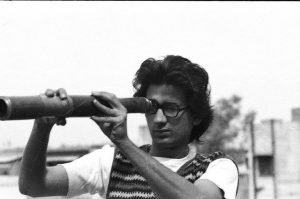“We are the inheritors of the legacy of Safdar Hashmi, you can’t silence us.”
Read a poster held at Ramjas College, during one of the protests in 2017. Sudhanva Deshpande, who was present there saw the poster and talked with the students about Safdar. A lot of things about Safdar Hashmi were not known to them. Sudhanva reminisced this event in a recent theatre workshop and said this was one of his inspirations to write Halla Bol, The Death and Life of Safdar Hashmi.
12th April marks the birth of this revolutionary theatre artist and a lot more. Safdar was a brilliant writer, director, actor, organizer, friend and comrade. The birth of Safdar Hashmi is celebrated as the National Street Theatre Day. Safdar has contributed and still does to the cultural resistance movement inspiring all forms of art.
Knowing Safdar
To be put simply, Safdar was born on this day in 1954. Joined St. Stephen’s college as a literature student at the age of 16 only. He was involved in Theatre and after a lot of action co-founded Janam, Jan Natya Manch. Janam previously did proscenium theatre but then financial constraints allowed street theatre only. Janam became a popular theatre group with various groups with the same name being formed and their plays being translated and performed throughout the country. Safdar also worked as a freelance writer, voice-over artist, director, Communist party worker and much more. On the ill-fated day of January 1, 1989, Janam was attacked while performing their play “Halla Bol” at Jhandapur. Safdar was blatantly injured and Ram Bahadur, a worker was killed. On the day of 2nd January 1989, Safdar Hashmi died. He was attacked and killed in political murder. The goons were led by Mukesh Sharma, the Congress candidate of that area.

Halla Bol, The Death and Life of Safdar Hashmi, the line following the title is intriguing for it mentions death before life. It is done so because it was the death of an artist that shook the nation. After reading it and after knowing Safdar personally, to read about Mala, Safdar’s green sweater, his connections with so many people, his dreams and ambitions, the loss feels personal. Though we know the major plot, just two words remain after reading about the attack on him – ‘Kyu’ and ‘Kaash’. 15,000 people joined Safdar’s funeral procession. As the writer and fellow mate of Safdar, Sudhanva Deshpande writes,
“I had begun to comprehend that Safdar’s killing had touched a raw nerve in the country. It had become a cause larger than Janam, larger than Safdar.”
Janam to date goes back to the site where Safdar was killed on 1st January and performs to celebrate him.

Safdar and DU
The book, Halla Bol talks about the theatre circuit, politics and culture of that time. The book brings out various interesting facts about the University of Delhi. Machine, the first street play performed by Janam which became a hit was performed for the first time at Satyawati College. Safdar even taught at Zakir Hussain College along with Bhisham Sahni, a highly acclaimed writer.
It mentions how until 1967, DUTA was “a pocket of powerful administrators” and how Kumaresh Chakravarty democratized the space by leading what was no less than a revolution after which DUTA changed and so did the varsity.
One of the most interesting things that are mentioned is a society called Delhi University Discussion Society (DUDS) that organized regular talks at the lecture hall of DSE (Delhi School of Economics). When Safdar joined St. Stephen’s college, it was the only college back then in DU where the canteen was referred to as a cafe.
Street Theatre and Change
In the pandemic, all the Drama societies are working their best to bring out something even on screen. But the element of being watched from all sides, the delineation between audience and performers which is a huge part of the street theatre is lost.
In Halla Bol and Theatre of the streets, a book on Jan Natya Manch one can find various narratives about street theatre. From it being anti-establishment to it being born out of social and economic compulsions as the voice of change.
The book also introduces its readers to a lot of names in the theatre circle and also trails its development. For all the thespians, Halla Bol is the book to read today, not only for Safdar but for the love of theatre. For the spirit of revolution and change that drives street theatre. For revisiting the echo of “Halla Bol” that still sounds in many plays of the Delhi University Theatre Circuit.
“Safdar’s life shows us how an artist can live in this world, not by embracing this or that identitarian cause, but by carrying within themselves a vision of human liberation transcending identities. A vision of liberation so glorious and boundless that it includes all the beings that inhabit this earth.”
-Sudhanva Deshpande
